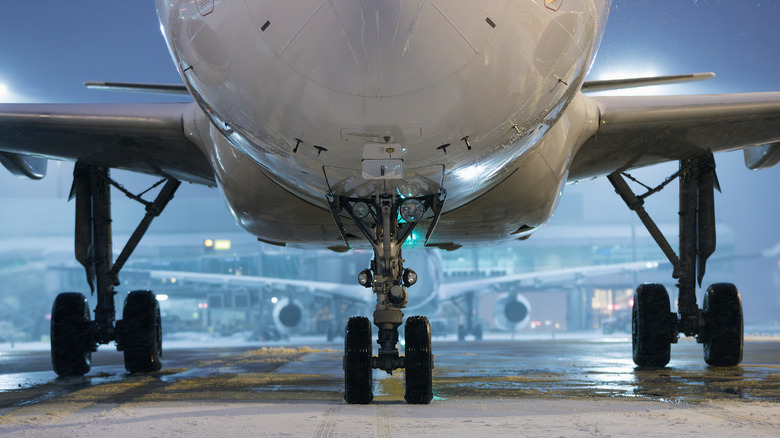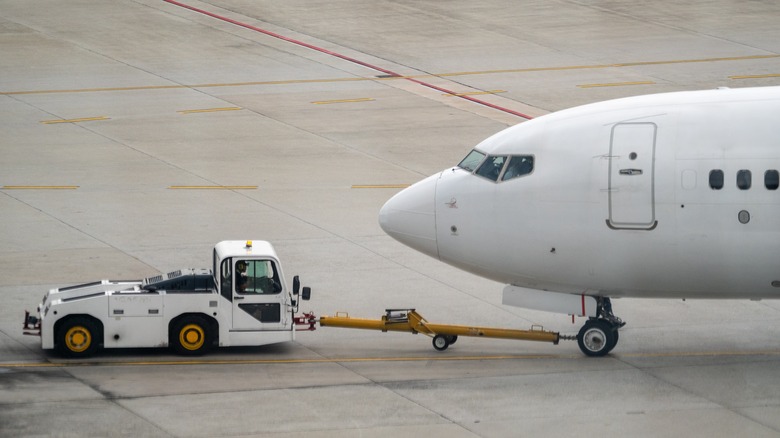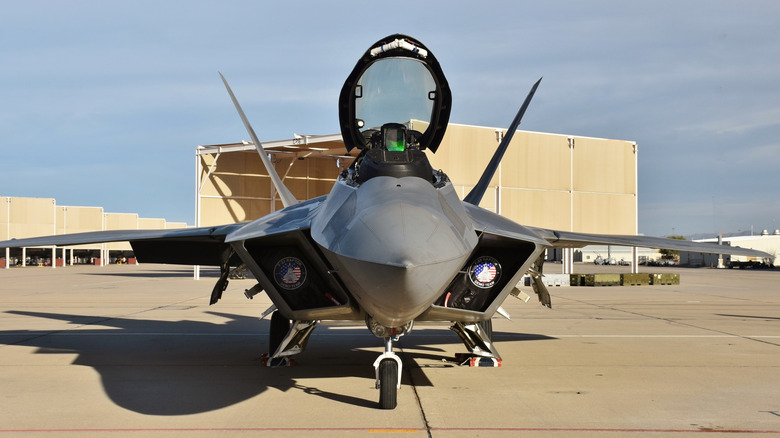How Do Planes Steer On The Ground?
Typically, unless they've been hit by a particularly egregious delay at the last moment, travelers spend the majority of their aircraft experience in the air, not on the ground. Nonetheless, taxiing across runways is an essential part of operating airplanes with pilots getting themselves into position for a flight. Larger commercial planes often have help from aircraft tugs, which can pull an impressive amount of weight for their relatively small size. It's not all about being cajoled into position by another vehicle, though, because a plane's hefty engines do give them the thrust they need to steer under their own power.
Doing so requires some specialized cockpit controls that may not be used elsewhere during a flight. Just as a car's steering wheel turns the front wheels — thus turning the whole vehicle — the steering wheel on a jet turns the nose gear in the desired direction, thereby directing its movement. The wheel of larger aircraft is instead referred to as a tiller. With aircraft varying so much in shape, size, and utility, however, it follows they don't all use the same method of steering while on the ground.
Moreover, there are additional tools and techniques used for specific scenarios while a pilot steers the plane on the ground. Thrust vectoring — which allows manipulation of the engines' angle of thrust — and differential braking — when an aircraft's brakes are prioritized on one side, turning the other — are just some examples.
Towing and braking are valuable tools
For convenience, safety, and simple practicality, tugs are sometimes used to replace or augment the movement of a grounded aircraft. Pushback tractors assist jets in the complex and potentially dangerous maneuver of moving in reverse on the ground. Taking a firm grasp of an aircraft via a connection beneath its nose, a tug of up to 70 tons can bear the weight of a plane weighing approximately 550 tons, and ferry it into position to await its next flight.
Differential braking is another complex maneuver that some planes can use to steer. This method sees pilots adjusting their manipulation of the brakes to impact one or the other side of the vehicle more. The differential, in doing so, will mean that the aircraft will turn in the desired direction. It's a bit of a laborious process, but this is often to be expected of a vehicle designed for flight. The appropriate method for differential braking depends on the type of aircraft in question.
For example, Aviation Safety Magazine notes that "for airplanes with a non-steerable, castering nosewheel (e.g., Cirrus), minimal differential pressure should be applied with the toes to assist in turning the airplane while using minimum power." Meanwhile, the likes of the Cessna 172, with its manageable top speed and range, can utilize this technique through its nose wheel, which can be steered in conjunction with careful direction of the rudder pedal.
Thrust can be the key
The thrust of an aircraft's engine has an enormous impact on its capability to fly — though planes can generally glide for a considerable distance even if they lose thrust from the engines – but it can also be used to direct its movement on the ground. Thrust vectoring is a function that allows a plane to direct the power of its engines using maneuverable nozzles, which is just as helpful on the ground as it is in the air. Thrust vectoring on the ground lets the plane change direction quicker, offsetting the common need to take slower, wider turns.
It's primarily used in the air by advanced aircraft like the F-22 Raptor, for which the enhanced agility and maneuverability could be vital to survivability. Though pilots can essentially steer an aircraft while on the ground in this manner, it's a predictably complicated matter. Needless to say, larger commercial airliners aren't built to swiftly slalom around bends like racing cars, and the most practical method can be to subtly 'course correct' the direction that they're taking while moving.
Positioning is absolutely vital for a safe takeoff. Airbus notes that differential thrust, a concept that revolves around differing the thrust output of the engines, can ensure the aircraft is at the precise angle it needs to be. As is always the case, a pilot needs to be acutely aware of what their aircraft is capable of and when it's appropriate to perform particular maneuvers in order to direct their metal steed to its destination safely.


